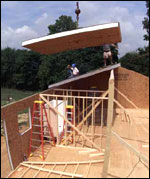Just off I-75 in Tennessee, halfway between Knoxville and Chattanooga, past a Home Depot, a Ford dealership, a Krispy Kreme, and a Piggly Wiggly supermarket, there is a newly developed tract of low-income homes built by volunteers of Habitat for Humanity.

A bright idea: the Indrajaya-
Kinandjar solar house.
At first glance, nothing about the development seems out of the ordinary. The houses are pleasant one-story colonials with porches, shutters, and carefully trimmed lawns strewn with tricycles and kick balls. But upon closer inspection, the development turns out to be more than just another housing project in sprawling Middle America; it is a testing ground for the affordable, zero-energy homes of the future.
The most obvious clue to the larger picture — a two-kilowatt BP Millenia thin-film solar system — can be seen glinting on the rooftop of the home of Adam Indrajaya and Lina Kinandjar, a landscape worker and pastry decorator, respectively, who moved to Tennessee from Malaysia six years ago. The solar panels were provided by the Tennessee Valley Authority (the public electricity supplier throughout the seven-state region of the Southeast) and the U.S. Department of Energy’s Oak Ridge National Laboratory (located just miles away in Oak Ridge, Tenn.), which teamed up with Habitat for Humanity to build this experimental settlement.
Even more impressive than the rooftop installation is the Oak Ridge-designed technology beneath it: special insulated walls, windows, and floors; energy-efficient lighting, appliances, and ducting; and state-of-the-art systems for heating, air conditioning, and hot water. The laboratory also added more esoteric efficiency measures, such as a system that captures the heat from shower water after it goes down the drain, and even one that captures the warmth that comes off the coils behind the fridge.

In hot water: the solar
house’s ultra-efficient
water heater.
Implanted throughout the house are dozens of sensors that monitor every detail of the family’s energy use — and with a large-screen TV, surround-sound stereo and DVD, fish aquariums, and two young kids who have better things to think about than closing the front door and turning out the lights, the Indrajaya-Kinandjar family’s living habits are no more energy-conscious than that of an average family in the U.S. (In fact, the couple had never heard of energy efficiency or solar panels before they discovered that Habitat selected their house “to get a special treatment,” as Kinandjar put it.)
Yet the family consumes roughly 25 kilowatt-hours* (kWh) of electricity a day — less than half the 60-kWh average in the U.S. And whether they intend to or not, the couple may be setting a lifestyle precedent for thousands, and perhaps millions, of others nationwide. Oak Ridge is working with the DOE to come up with a prototype house that, by 2010, will cost the same to build as a conventional middle-class home while being 50 to 70 percent more efficient and functioning as a net-zero-energy home (meaning it can produce as much energy per year as it consumes). “Right now, all too frequently, the typical solar home is something akin to a customized Cadillac,” said Jeff Christian, director of the Buildings Technology Center at Oak Ridge and the man in charge of the Habitat for Humanity project. “What we’re trying to do is come up with the Volkswagen of net-zero-energy homes.”
This goal has powerful and far-reaching implications — not just for addressing America’s escalating power demand, but also for controlling that of developing countries, which are expected to experience dramatic growth in home-building and energy demand in the next several decades. But there are significant barriers to making the net-zero vision a reality, not the least of which is the Bush administration’s efforts to slash federal investments in energy efficiency, renewables, and zero-energy homes by roughly half since it came to power. (Funding for Zero Energy Building projects alone would be cut from $8 million to $4 million by the current Bush plan.) To meet the 2010 goal, according to Christian, the country will have to see a steep reduction in the price of solar, from roughly $15,000 to $18,000 dollars for a typical (two-kilowatt) system today to about $3,000 to $5,000 for that same system in seven years.
No small feat — but if consumer demand continues to grow, and if Congress passes a Renewable Portfolio Standard (incorporating a benchmark set in the 2002 Senate version of the energy bill that called for 10 percent renewables by 2020), and if we get a different president in office who will sign off on it, the goal would be eminently reachable. Granted, all those “ands” make the forecast cloudy at best, but still, there is a ray of hope: In the absence of federal-level support, there is a steadily growing effort among traditional utilities — and, more importantly, their customers — to bring renewables into their energy mix. In Tennessee, this trend is exemplified by the involvement of the oldest and largest public utility of them all, TVA.
I Want My TVA
To be sure, TVA is a far cry from an eco-sensitive outfit. On the contrary: It is infamous for being one of the top polluters in the nation, deriving more than 60 percent of its power from coal-fired plants (most of them dinosaurs) and the remainder largely from nuclear. But in the last two years, pressured by a growing concern for the failing environmental health of the Tennessee Valley, TVA has added nearly 3 megawatts of wind, solar, and methane gas capacity (and is in the process of adding about 27 MW more of wind capacity) for its “Green Power Switch” program, which offers customers the option of paying a monthly premium for solar- and wind-generated electricity. TVA’s program was the first in the country to allow consumers to pay extra for renewable energy; the energy is accredited (that is, guaranteed to be clean) by an outside organization called the Center for Resource Solutions). Thirty MW may not sound like much, given that TVA’s total capacity is 30,000 MW, but it’s a lot more than we’re seeing from most other utilities.
“They resisted the idea at first,” said Steven Smith, director of the Southern Alliance For Clean Energy, which was the driving force in helping TVA develop the program. “They simply couldn’t believe that people would pay more every month for clean energy. But it’s been a tremendous success, and is becoming the gold standard for other programs like it throughout the South.”
In just two years, more than 7,000 residential customers (out of 3.4 million total accounts) in the Tennessee Valley have signed up for the program, making it one of the biggest in the nation in terms of both participants and capacity. Sixty-four of TVA’s 158 distributors are cooperating, and there’s a waiting list of many more. As a result of the unexpectedly positive response, TVA has launched another program called Generation Partners, which offers homeowners the option of installing their own rooftop solar system or windmill and selling the electricity generated back to TVA for 15 cents per kWh, more than twice the going rate for traditionally generated juice. The Indrajaya-Kinandjar house is the flagship project — the first private residence in the Southeast selling pollution-free solar electricity back to the grid.
Is That the Chattanooga Choo-Choo?
That flagship project has been a long time coming: The Southeast is one of the last regions in the country to catch on to the renewables trend, according to Smith. “Compared to costal regions like California and the Northeast, utilities in the Southeast have been really reluctant to invest in renewables,” he said. In part, that’s because of the preponderance of coal in the region’s energy mix, which has famously given the South some of the cheapest electricity in the nation — about 6 to 7 cents per kWh, compared to an average of 10 to 12 cents elsewhere. That low price makes renewables even less cost-competitive than they are in other parts of the country. Furthermore, environmental organizations have far less of a presence in the South than they do elsewhere — and those that do exist tend to be less well-funded than their counterparts in other places, because the region also suffers from a lack of environmentally minded foundations.
In the last five years, Nashville, Memphis, and Chattanooga (all located in the Tennessee Valley) have made it onto the list of the most polluted cities in the country. What’s more, the area’s Great Smoky Mountains National Park has become the most polluted national park in the United States — earning its name in more ways than one. But, on the upside, these problems are driving people to seek solutions. “We are seeing a very clear correlation between the people who sign up for the Green Power Switch and people who live in the areas surrounding the park,” said Smith. “They are very clearly saying, ‘We are willing to pay more for our electricity in order to help clean up the region.'”
The operative phrase here, of course, is “willing to pay more.” TVA makes no bones about the fact that its renewables programs are not charity cases. “These programs depend on people who have the desire and resources to pay the extra increments it costs to add renewable generating capacity to our mix,” said Skila Harris, who served in the DOE during the Clinton administration and is now codirector of TVA. “Alternative-fuels technology really haven’t yet proven to be something we can do and keep our rates as low as feasible. And offering the lowest rates possible is the No. 1 priority at TVA.”

Power on: installing
rooftop solar.
Photo: Oak Ridge National
Lab.
Ed Colston, marketing manager at TVA and director of the Generation Partners program, puts it more bluntly: “We are not trying to change the world,” he said, “we’re just trying to make that option available — in a way that makes practical sense for our bottom line.” To wit, the Generation Partners program is nearly cost-free for TVA. They are putting no money whatsoever into marketing the program, relying instead on grassroots environmental organizations like the Southern Alliance for Clean Energy to spread the word among their constituents. And while TVA did donate the solar panels for the Habitat house, it was simply for the sake of demonstration; in all subsequent projects, the homeowner will have to pay for the system.
“We are appealing to a constituency out there that would be putting solar and wind on their homes anyway,” said Colston. Still, the program has its advantages: For those who do want to add renewables to their home, TVA makes the process much quicker and easier — addressing safety concerns with local distributors and smoothing out the technical issues related to interconnecting the system to the grid (which can be a tedious and time-intensive challenge with some utilities). Plus, TVA sweetens the deal by buying back the home’s solar energy at a premium rate.

A TVA wind project on Buffalo
Mountain in Tennessee.
Photo: DOE.
That’s more incentive than most utilities offer. But in the long run, it may be as good a deal for TVA as it is for the customer: The Generation Partners program is an easy alternative to adding solar to the Green Power Switch program. Because it has cost TVA almost 10 times more to install solar projects than to build wind farms, the utility has basically abandoned the former in favor of the latter. “We will essentially pay less to help these homeowners add the solar generation themselves than we would to go and build those projects ourselves,” said Colston. Right now, of TVA’s roughly 30 MW renewables capacity, 0.5 MW is solar-generated.
Steven Smith does find it somewhat perturbing that TVA is so doggedly bottom-line-oriented in its approach to renewables, but still, he said, the program represents a major step forward.
“On the one hand, it frustrates me that customers have to elect to buy clean energy, and yet when TVA adds, say, a new nuke plant, which has huge up-front costs, they just stick that into the base rate and increase the bills without asking,” said Smith. On the other hand, he notes, proving that a profit-driven model can work is itself incredibly useful: “You have to crawl before you walk and walk before you run, and TVA is the first one crawling. They’ve taken a powerful leadership role in the South. Because of their example, we now see utilities in nearby Southern states, including North Carolina and Georgia, adding similar green-power programs.” TVA has proved to everyone the most important point of all: Customers want it, and they’re willing to pay for it.
You Turn Me On
It’s true that TVA is playing an instrumental role in tapping the all-important well of early adopters. Your own loyal Grist columnist is a Nashville resident and a member of the Green Power Switch program, so I can vouch for the fact that becoming an “early adopter” was as easy as dialing seven digits and saying (or zealously shouting, in my case): “I want to make the Green Power Switch!”

A step ahead: Indrajaya and
Kinandjar on their front porch.
Photo: TVA Generation Partners.
It only costs me an extra $12 a month to get nearly all of my electricity needs powered by TVA’s wind farms and solar installations. I consider those to be about the 12 most satisfying bucks I drop each month. But then again, I’m an energy nerd with no dependents, and I’m well aware that such an expenditure would not be as painless for, say, Indrajaya and Kinandjar, who have two children to look after and house and school payments to juggle. In the face of more pressing financial concerns, anyone might reasonably decide that throwing money at windmills is, well, quixotic.
And given that neither the Green Power Switch nor the Generation Partners program is likely to have a dramatic effect on sales of solar panels in the next seven years (TVA hopes to get a grand total of “up to” 15 houses into Generation Partners in the next year), they are also not likely to do much to advance Christian’s bold vision of releasing the Volkswagen of net-zero-energy homes by 2010.
“The message is simple,” said Smith. “TVA is doing a good job of getting the ball rolling, but to get these programs to take off in a big way you need federal-level efforts — in particular a Renewable Portfolio Standard that requires a certain percentage of the whole generation mix in this country to come from renewable energy.”
TVA’s Harris herself suggested that the prospect of an RPS was part of what was propelling the shift toward renewables among utilities nationwide. “Utilities are beginning to recognize [the desire for renewable energy as] a growing trend among both consumers and policy makers. … The Renewable Portfolio idea has been hanging around Washington for so long, and typically lawmakers get worn down over the years and say, ‘Okay, we’ll put something in there on that.’ And when that happens it’s to your advantage, from a cost standpoint, to have already started such a program. Smart businesses want to be ahead of the curve.”
Extending his Volkswagen metaphor, Christian argues that, in the world of building development, the zero-energy solar home is the equivalent of the Freedom Car (the Bush administration’s moniker for the fuel-cell car of the future). After all, buildings produce a large percentage of carbon dioxide emissions in the U.S., so decreasing those emissions would make a big difference. Said Christian, “The attitude in Washington should be: Let’s everybody put the best brains on it, let’s put it up there with the man on the moon, with the Freedom Car. Let’s make it the grand challenge.”
*[Correction, 24 Oct 2003: The kilowatt-hour is the correct unit of measurement for household electricity use, not the kilowatt, as originally stated in this article.]


